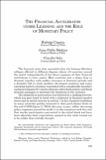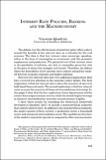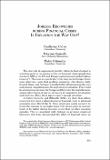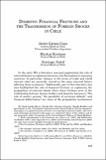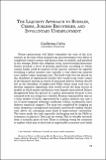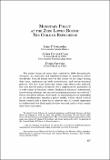Search
Now showing items 111-120 of 135
The financial accelerator under learning and the role of monetary policy
The financial crisis that unraveled after the Lehman Brothers collapse affected in different degrees almost all countries around the world independently of the direct exposure of their financial institutions to toxic assets. Most countries saw a sharp drop in demand together with sudden increases in ...
Interest rate policies banking and the macroeconomy
The debate over the effectiveness of monetary policy often centers around the benefits of low interest rates as a stimulus for the real economy. The idea is that low interest rates encourage spending either in the form of consumption or investment and this promotes employment and production. The ...
Trilemmas and tradeoffs: living with financial globalization
This paper evaluates the capacity of emerging market economies (EMEs) to moderate the domestic impact of global financial and monetary forces through their own monetary policies. I present the case that those EMEs able to exploit a flexible exchange rate are far better positioned than those that devote ...
Jobless recoveries during financial crises: is inflation the way out?
The slow rate of employment growth relative to that of output is a sticking point in the recovery from the financial crisis episode that started in 2008 in the U.S. and Europe (a phenomenon labeled 'jobless recovery'). The issue is a particularly burning one in Europe where some observers claim that ...
Domestic financial frictions and the transmission of foreign shocks in Chile
In the early 90’s a literature emerged emphasizing the role of external factors in explaining business cycle fluctuations in emerging countries. In particular changes in the terms of trade and world interest rates are generally viewed as the main external factors affecting these economies. Additionally ...
International aspects of the zero lower bound constraint
Large negative aggregate demand shocks can drive down an economy’s equilibrium real interest rate and if the central bank is committed to stabilizing inflation monetary policy may be hampered by the zero lower bound on nominal interest rates –the economy may be in a 'liquidity trap.' The policy dilemma ...
Credit stabilization through public banks: the case of Banco Estado
A novel element in the policy mix that responded to the 2008- 2009 financial crisis was the explicit role given to BancoEstado a publicly-owned commercial bank to alleviate the contraction in domestic credit provided by the banking sector. In order to aid its mission BancoEstado was capitalized by 500 ...
The liquidity approach to bubbles crises jobless recoveries and involuntary unemployment
Future generations will likely remember the turn of the 21st century as the time when mainstream macroeconomics was about to completely remove money and finance from its models and perished in the attempt. Before the subprime crisis macroeconomic/monetary theory reached a level of pristine perfection ...
Monetary policy at the zero lower bound: the Chilean experience
The global financial crisis that started in 2008 dramatically changed the analysis and implementation of monetary policy worldwide. Central banks were at the center of the stage during that time implementing both conventional and unconventional policies. Not only were monetary policy rates drastically ...
Sterilized foreign exchange interventions under inflation targeting
Inflation targeting needs exchange rate flexibility. If the policy interest rate is geared to achieving the inflation target the central bank must be willing to accept the resulting exchange rate. Simply put if the central bank has both an inflation target and an exchange rate target the private sector ...

